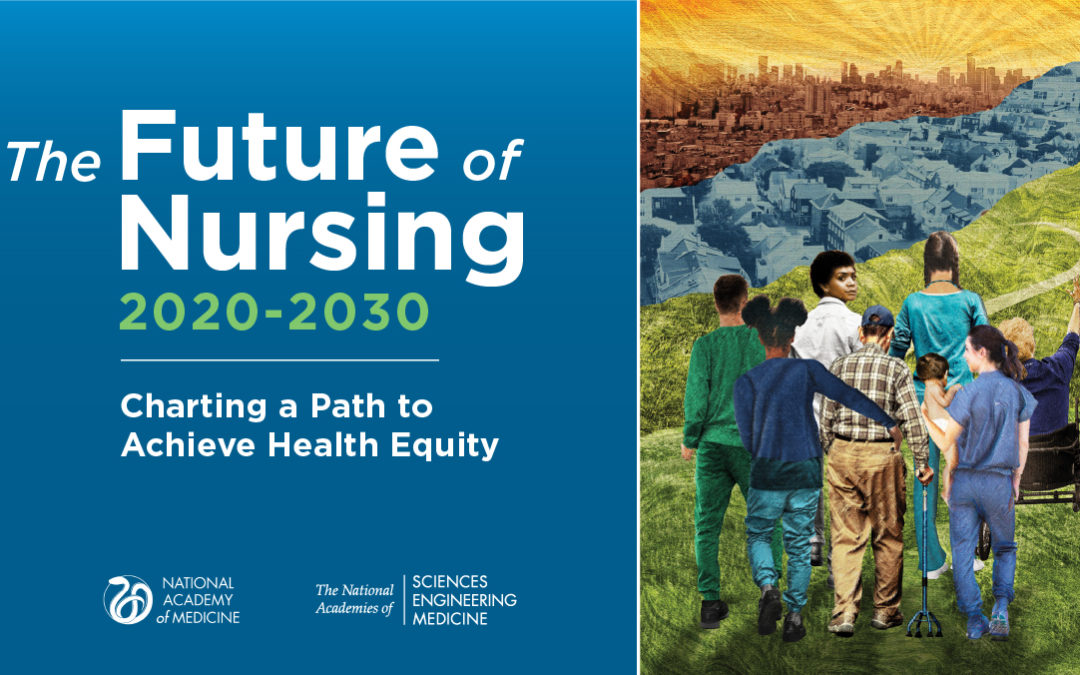
Future of Nursing 2020-2030: Strengthening Nursing Education
This year, the National Academy of Medicine Committee on the Future of Nursing 2020-2030 issued The Future of Nursing 2020–2030 Charting a Path to Achieve Health Equity report. Sponsored by the Robert Wood Johnson Foundation, the report explored many areas critical to the future of the nursing industry–from education to disaster response.
Minority Nurse spoke with Marcus Henderson MSN, RN, lecturer at the University of Pennsylvania School of Nursing and a member of the Committee on the Future of Nursing 2020–2030 about the report’s findings on the future of nursing education.
Henderson, who specializes in psychiatric nursing and nursing in the community, says looking at nursing through the lens of community health competencies is a critical component of comprehensive nursing education.
Community Health in Nursing Education
Although Henderson says community health is covered in nursing education, the standards in place don’t reveal how often or how well community health and public health nursing competencies are covered in individual programs. Sometimes it’s just as one course or an elective course.
“We argue in the report that these areas of community health, public health, social determinants, and population health need to be comprehensively threaded throughout the curriculum,” Henderson says, “so it’s not an add-on. It’s baked in fundamentally into everything we do in our nursing practice.” As nursing education changes, schools and students will begin to collaborate more across disciplines.
Changing how nursing is taught and how students gain experience means more nursing students need to spend time working in various community settings. Nurses learn best through experiential learning, says Henderson, especially with community-based social issues. “Put students in the community and put students in settings where they are finding experts,” he says. And when students find the specialty that appeals to them, letting nurses deviate from the typical path will get them started quickly. “Telling nurses they need one to two years of med-surge under their belts is unnecessary,” says Henderson, “and we have to stop perpetuating that.”
Experience in the Right Settings
For nurses who know they aren’t interested in a med-surge path, those two years could be better spent gaining targeted skills. Immersing themselves with on-site community health work strengthens their commitment to the role.
“Without that kind of immersion, you are reinforcing stereotypes because what you read is not contextualized by what happens,” says Henderson. For instance, he says, nurses may read that “because you’re African American, you’re more at risk for ‘A'” or “because you live in this community, you’re more at risk for ‘Y.'” It’s not contextualized as to why any health impacts are happening, he says.
Nursing education depends on nurses understanding the socioeconomic influences of disease. Henderson says nurses who are immersed in a community may see that patients lack access to green spaces to exercise or may not feel safe in their neighborhood. They may see patients don’t have easy and affordable access to healthy foods.
“The context is the patients don’t live in a community that sets them up to eat healthy, exercise, and take care of themselves to reduce the risk for something like diabetes,” he says. “It has nothing to do with them being African American and has to do more with community conditions. You have to see that and experience it.” Henderson, whose own career was deeply influenced by his early work in community health, says nurses can’t address the health needs in a community without addressing the social needs. “The community is the teacher,” he says. “We go into a community with preconceived notions. But patient-centered care is community-centered care.”
Reading something in a book gives nursing students a theoretical background, but going out into the community, often sparks a passion about uncovering a solution to the root causes of some of the issues patients are facing. “There are downstream effects of that,” says Henderson.
Shift in Nursing Education
As nursing education changes to a community focus, nursing students will need faculty leaders who can talk to them about how to change approaches to tasks like screenings.
“One of the biggest hurdles is getting students out of the mindset of I have to get out to do a specific task,” he says. “It’s about what kinds of conversations are you having during the screening when you’re checking someone’s eyes. Are you learning about their home life? In community public health, you’re exploring the issues that are surrounding their lives and the issues that impact their wellness so you can focus on intervention and prevention.” Nursing students have to be taught about it in their classroom work so they can merge their knowledge and hands-on experience to examine the root causes of illness differently.
Workforce Preparation and Qualification
People want to work in the settings they are exposed to, says Henderson, so nursing students should work in settings that let them see a nurse’s role in schools, correctional facilities, public libraries, preschools, community health centers, homeless shelters, and public housing, and learn from the experts who work in those settings.
Sometimes, says Henderson, the best professional to explain those topics are the ones on the front lines, like the social workers or school counselors who see people for issues that might not be related to an immediate health concern, but that most certainly impact health. With a chronic nursing faculty shortage, allowing educators who don’t have a nursing degree might help fill some gaps in staffing and course content, he says.
Henderson says the Future of Nursing Report calls for including curriculum topics around nursing policy, structural racism, and health equity to help nurses over their entire careers.
And, Henderson says, the report also advocates for nursing schools to address racism in society and within its own professional structures. “Nursing as a profession for a long time hasn’t addressed how racism has impacted our own profession,” says Henderson. “We say in this report we want to go out and do all this good and improve health equity, but we still have to clean our own house a little bit and examine how nurses of color are still discriminated against within our own schools and our own workplaces. And we talk about that in this report and that’s crucial.”
Higher education also must take a new look at its environment. “Schools of nursing need to acknowledge the impact of structural racism has within their own institution and how that disadvantages nursing students and faculty of color,” says Henderson. “That means critical examination of curriculum policy practices, curriculum strategies, and how they allocate resources. Who has the power and what do those dynamics look like?”
Diversity and Equity
A diverse, inclusive, and equitable nursing environment needs to be clearly defined. “Many people say diversity and think just by being diverse, we are equitable,” Henderson says. “But that’s not the case. You can be diverse but not equitable. You can have diverse people at the table, but it’s not equitable if they aren’t valued and their voices aren’t heard.” Lots of groups are recognizing that, says Henderson, but now they have to decide how to act on it and raise awareness about it.
Continually advocating for change in nursing and working to keep uncomfortable conversations ongoing and productive encompasses topics both new and historic, says Henderson, and is the focus of the next decades of nursing education. “It’s about who is having these conversations,” he says. “If we keep having the same people at the table, we won’t get far.”



